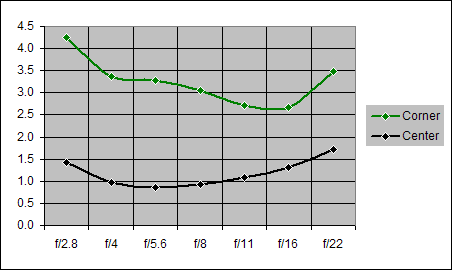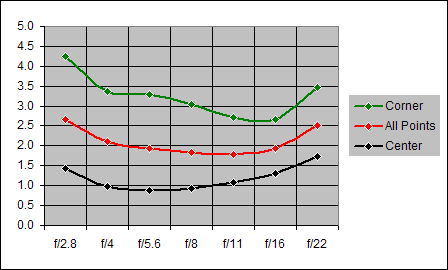 Nikon 14mm f/2.8 Tanner Report
Nikon 14mm f/2.8 Tanner Report Nikon 14mm f/2.8 Tanner Report
Nikon 14mm f/2.8 Tanner ReportWhen the situation calls for a wide-angle lens, the Nikon 14mm f/2.8 fits the bill. Whether it's a wide landscape in the open or a "wide" group shot in cramped quarters, this lens qualifies. A 14mm lens on a camera with a sub-frame sensor isn't as wide as it was on a full-frame 35mm film camera, but it still gives you a nice, wide view (on a Nikon DSLR with a "DX" sensor, about equivalent to a 21mm lens on a film SLR), going a good bit wider than the 18mm wide end of a lot of zooms. (Plus, at f/2.8, this lens is a lot faster than typical "kit" lenses.) Read on and see how well the Nikon 14mm f/2.8 might fit your needs.
Center Sharpness
A quick look at the sequence of Blur Index plots (presented with each SLRgear lens review) immediately indicates a lens that has pretty good center sharpness and questionable corner sharpness throughout its aperture range. Each plot in this sequence presents data from one of the many images shot at the aperture indicated on the slide. We generally shoot between 10 and 20 images for each aperture/focal length pair and then select that image with the lowest center blur index as the image to use in this report. This ensures the image with the best "center sharpness", but it leaves the corner sharpness vulnerable unless the focus surface (the surface formed by the lowest blur index for each point in the image) of the lens is very "flat". In this ideal case, the surface of camera's sensor coincides with the flat image and the corresponding blur plot for that aperture is flat. These focus surfaces for the Nikon 14mm f/2.8 do not exhibit this generally desirable "flatness". We will return to this in the discussions of corner and all-points sharpness which follow this section.

Figure 1. Center Sharpness for Nikon 14mm f/2.8
Figure 1 is a graph of this "best" center sharpness for each aperture in the f/2.8-22 range of the Nikon 14mm f/2.8 lens. Using DxO's blur index range of sharpness of 0.5-1.5, this lens is sharp from wide-open (f/2.8) through f/16. Even at f/22, where diffraction has begun to noticeably degrade the image, the center sharpness is still only slightly soft. Thus, we judge the Nikon 14mm f/2.8 lens to exhibit a very good "Center-Sharpness" performance.
Corner Sharpness

Figure 2. Corner and Center Sharpness for Nikon 14mm
Figure 2 adds to Figure 1 a (green) curve representing the average blur performance for the four corners. This curve gives substance to the corner softness seen earlier in the SLRgear Blur Index sequence. The six blur values for apertures f/4-22 are in the range considered by DxO to be "Blur Visible" (2.5-3.5), while the f/2.8 value fall's in DxO's "Blur Unacceptable" range (3.5-4.5). This is a poor "Corner-Sharpness" performance by the Nikon 14mm f/2.8.
Overall Sharpness

Figure3. Corner, Overall, and Center Sharpness for Nikon 14mm
The (red) curve of Figure3 shows the overall performance of the Nikon 14mm lens in this test. At each aperture, the "red curve" value represents the blur-index average of all points on the selected image. This curve (excepting the f/2.8 value) falls completely in the (DxO) "Soft" range (1.5-2.5), and the f/2.8 value falls in the "Blur Visible" range (2.5-3.5). Again, we have a somewhat disappointing performance by the Nikon 14mm f/2.8.
Chromatic Aberration
The usual SLRgear Chromatic Aberration graph provided at this site indicates an average CA performance for the Nikon 14mm f/2.8 lens. At the wider apertures (f/2.8-4) Maximum and Average CA values in the 2-5 (DxO units) range represent slightly better than average values when compared to a number of other lenses. For higher apertures (f/8-22) CA values in the 4-9 range are, at best, average when compared to other lenses. While there are a number of lenses (see Competition Section below) that appear to be very comparable to the Nikon 14mm f/2.8, we have not yet tested them. Thus, our evaluation of an "average" CA performance is somewhat tentative. As comparable lenses are tested, we will offer direct comparisons with this lens.
Shading ("Vignetting")
The usual SLRgear Light falloff (Vignetting) graph provided at this site reveals Shading values that start at about 1.2 EV at maximum aperture and decrease monotonically to values in the 0.3-0.4 EV range as the lens is stopped down. When compared to other lenses (Nikon 24mm f/2.8 and Canon 16-35mm f/2.8L: 16mm) which have corresponding wide-open and full-range values of (0.6 EV, 0.25 EV) and (0.2 EV, 0.12 EV), respectively, the Shading performance appears to be relatively poor. It will be interesting to contrast this performance with that of more comparable lenses (See the Competition Section below).
Distortion
With Maximum and average Distortion values of 0.6% and 0.4%, the Nikon14mm f/2.8 lens displays a distortion similar to but somewhat greater than a number of other lenses, the Canon 16-35mm f/2.8L:16mm (0.8%, 0.5%) and the Tokina 12-24mm f4: 15mm (0.31%, 0.11%), and the Nikon 12-24mm f/4 DX: 15mm (0.37%, 0.13%). Thus, until we can perform tests on more comparable lenses, we assign a slightly below-average rating to the Nikon 14mm f/2.8's Distortion performance.
AF Operation
The Nikon 14mm f/2.8 lens focuses rapidly and relatively quietly, although its use of the body-based motor does make it noisier than lenses with built-in ultrasonic motors. From infinity to closest focus (about 3 inches or 8cm) lens-to-target-distance) the focusing time is under one second, a good performance. At closest focus on the Nikon D200 body (1.5x crop factor), the width covered is about 6.3 inches (16 cm), surprisingly close focusing and a surprisingly small minimum area for a lens of this sort. Because it relies upon a gear train and the camera body's focus motor, manual focusing cannot be performed while in the AF mode.
Build Quality and Handling
This is a very sturdy, relatively heavy lens. It feels tank like and balanced very well on our D200 body. The manual focusing works very smoothly, with plenty of travel to make precise focusing easy. No question, this is a very well-built, quality lens.
Competition: Primes
There are a number of 14mm lenses currently on the market, none of which have we yet had the opportunity to test. Among them are (with estimated street prices): Sigma 14mm f/2.8 HSM, $899; Tamron 14mm f/2.8, $1000; Canon 14mm f/2.8L, $1800; and the (not 14mm) Tokina 17mm f/3.5, $560. The Sigma, Tamron, and Tokina lenses offer Nikon mounts. There's also a Pentax 14mm f/2.8 lens which sells for about $625.
We are endeavoring to obtain copies of some, if not all, of these lenses in order to offer apples-to-apples comparisons. As we do so, we will update this report.
Competition: Zooms
In considering the Nikon 14mm f/2.8 lens, it might pay to think about what you're looking for, whether you simply want a really wide-angle lens, or whether the Nikkor's fast f/2.8 maximum aperture is also of critical importance. If your primary interest is simply in capturing a really wide field of view, you may want to consider some of the ultrawide zooms on the market. These tend to have smaller maximum apertures, but many compete very well against the Nikon 14mm f/2.8 in terms of other optical characteristics. Looking to the zooms, the obvious competitors to the Nikon 14mm f/2.8 would be Nikon's own 12-24mm f/4 DX (tested), the Sigma 10-20mm f/4-5.6 EX DC HSM (tested), the Sigma 12-24mm f/4.5-5.6 EX DG Aspherical HSM, and the Tokina 12-24mm f/4 AT-X 124 AF PRO DX (tested). Here's a brief digest of each of these:
Nikon 12-24mm f/4 DX
This was one of Nikon's first "DX" lenses, designed to cover only the smaller APS-C size image circle of the sensors on Nikon digital SLRs. It goes a bit wider than the 14mm f/2.8 prime, but its f/4 maximum aperture is a full stop slower. Near the 14mm focal length (the nearest focal length we tested was 15mm), the 12-24mm f/4 shows roughly similar center sharpness, but better corner sharpness at f/4 than does the 14-f/2.8 at that aperture, and at f/5.6, the zoom's overall sharpness is significantly better, although the 14-f/2.8 does a bit better in the center. The zoom's chromatic aberration at 15mm is slightly worse at f/4, but is lower than the prime's at higher apertures. Geometric distortion is somewhat lower, and shading ("vignetting") is substantially better. With street prices for the 12-24mm running around $900-950, it's also a good $400+ cheaper than the 14-f/2.8. I'd thus argue that the 12-24mm f/4 DX is a much better choice, provided you don't need the f/2.8 maximum aperture of the 14mm prime.
Sigma 12-24mm f/4.5-5.6 EX DG
With street prices in the range of $640-690, this Sigma lens could be a real bargain relative to either of the Nikons, although it does have a smaller (and variable) maximum aperture than the Nikon zoom. We haven't tested the Sigma 12-24mm yet as of this writing (in mid-April, 2007), but will try to get a sample to test, and come back to update this note once we've done so.
Sigma 10-20mm f/4-5.6 EX DC HSM
This Sigma lens is another (like the Nikon 12-24mm) that's designed to cover only the smaller sensor size of most digital SLRs. It goes a lot wider than the Nikon 14mm prime, reaching all the way down to 10mm. One price though, is a smaller maximum aperture that ranges from f/4-5.6 depending on the focal length setting. (It's f/5 at 14mm.) Compared at a focal length of 14mm, this Sigma zoom is a little softer in the center, but much sharper in the corners than the Nikon prime, has much lower CA, and somewhat lower geometric distortion and shading. Best of all, it sells at street prices of only $450-500, much cheaper than either Nikon option.
Tokina 12-24mm f/4 AT-X 124 AF PRO DX
This lens is a twin of the Nikon 12-24mm, in that it shares the same focal length range and the same (constant) maximum aperture. It's also designed with a smaller image circle, suitable for cameras with APS-C size or smaller sensors. At 15mm (the nearest focal length to 14mm that we tested), the Tokina isn't quite as sharp at the center, but again offers much better corner sharpness than the Nikon prime. Sharpness uniformity also continues to improve as you stop down. The Tokina's CA is a bit higher than that of the Nikon at large apertures, but improves as you stop down, equalling that of the prime at f/8, and surpassing it at smaller apertures. Geometric distortion and shading are both considerably better than the Nikon 14mm f/2.8, at any aperture.
Conclusion
Our copy of the Nikon 14mm f/2.8 lens was a sturdy, well-built, excellent focusing lens. Unfortunately, its optical performance (sharpness, chromatic aberration, shading, distortion) was a little marginal, especially for a lens selling in the vicinity of $1400. We haven't (yet) had the chance to compare it to competing 14mm prime lenses available for the Nikon mount, but most of its optical characteristics are surpassed by any of several zooms available on the market for considerably less money. If you really need an f/2.8 maximum aperture at 14mm, the Nikon 14mm f/2.8 prime may be a good choice. But if maximum aperture isn't all that important in your shooting, you can do a lot better with any of several ultrawide zoom lenses instead.